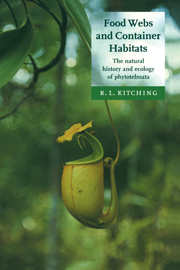Book contents
- Frontmatter
- Contents
- Preface
- 1 Introduction
- Part I The container flora, fauna and environment
- Part II Methods and theories
- Part III Patterns in phytotelm food webs
- 7 Food-web variation across geographical regions
- 8 Food-web variation within a continent: the communities of tree holes from Tasmania to Cape Tribulation
- 9 Food-web variation at smaller spatial scales: regional and local variation in tree-hole and Nepenthes webs
- 10 The role of the host plant
- 11 Variation through time: seasonality, invasion and reassembly, succession
- Part IV Processes structuring food webs
- Part V Synthesis
- Annexe: The phytotelm bestiary
- References
- Index
7 - Food-web variation across geographical regions
Spatial patterns: the global scale
Published online by Cambridge University Press: 26 August 2009
- Frontmatter
- Contents
- Preface
- 1 Introduction
- Part I The container flora, fauna and environment
- Part II Methods and theories
- Part III Patterns in phytotelm food webs
- 7 Food-web variation across geographical regions
- 8 Food-web variation within a continent: the communities of tree holes from Tasmania to Cape Tribulation
- 9 Food-web variation at smaller spatial scales: regional and local variation in tree-hole and Nepenthes webs
- 10 The role of the host plant
- 11 Variation through time: seasonality, invasion and reassembly, succession
- Part IV Processes structuring food webs
- Part V Synthesis
- Annexe: The phytotelm bestiary
- References
- Index
Summary
The subtropical rainforest of south-east Queensland is a far cry from the deciduous woodland of southern England. Walking south from O'Reilly's Lodge towards the New South Wales border I pass the giant liane-draped trees of the rainforest. The strange Gondwanan hoop pines are interspersed among red carrabeen and black booyong, strangler fig and brush box. Here one can pass sixty or seventy species of tree in a kilometre's walk, many of them carrying crowns of crows' nests and orchids, stagshorns and mistletoes. Among the trees and epiphytes are the homes of mound-building scrub turkeys and the rifle bird, Australia's bird-of-paradise. Ring-tailed possums and red-necked pademelons bring a mammalian presence to the forest, complicated by the occasional dingo and marsupial native cat. And here too one may stumble upon python and black snake, forest dragon and leaf-tailed gecko. The list of plants and vertebrates alone is hundreds of entries long. In fact this is a rainforest, not as rich as the ones further north in Queensland and beyond but, nevertheless, a place of great biological excitement and richness.
In contrast, the biological riches of Wytham Woods in Berkshire are altogether more understated, although nonetheless significant in their way. Strolling along the Singing Way on a summer's day thirty years ago, I recollect spreading beech trees, planted almost 200 years earlier along the old London to Oxford stage road, now reduced to a muddy track. Beeches are interspersed with oaks and ashes, horse chestnuts and limes, but the list is modest.
Information
- Type
- Chapter
- Information
- Food Webs and Container HabitatsThe Natural History and Ecology of Phytotelmata, pp. 139 - 175Publisher: Cambridge University PressPrint publication year: 2000
